OVERVIEW
ECONOMIC SUMMARY
Growth in Western Australia's domestic economy slowed during the June quarter 2006, with State Final Demand increasing by 2.9% in trend chain volume terms, compared to growth of 3.2% in the previous quarter. Despite the deceleration, growth in Western Australia (2.9%) was more than three times that of Australia's growth in Domestic Final Demand of 0.8%. In seasonally adjusted chain volume terms, Western Australia's State Final Demand rose by 5.6% ($1,443 million) in the June quarter, the highest of all states and territories. The main driver of growth was Private business investment, which rose by $670 million (11.7%), mainly on Non-dwelling construction and Intangible fixed assets.
Reflecting the ongoing strength of Western Australia's economic growth, the state has experienced stronger growth in consumer prices and wages than nationally. Perth's Consumer Price Index rose by 4.7% through the year to June quarter 2006, much higher than the 4.0% growth recorded nationally, while the state's Wage Price Index rose by 4.6% over the same period, compared to national growth of 4.2%.
The value of Western Australia's exports rose by 16.4% ($1,812 million) through the year to June quarter 2006. The major commodities contributing to the increase were gold, iron ore and nickel ores. Exports of petroleum detracted from growth during the period, as a result of the prolonged impact of Tropical Cyclones Clare and Glenda on oil production. Western Australia's exports growth was outstripped by the growth in imports of 65.3% ($2,544 million) through the year to June quarter 2006. Gold, a large floating offshore storage facility and refined petroleum oils were the major commodities driving the increase in imports.
Employment in Western Australia continued to grow solidly, with the number of employed persons rising by 6,600 (0.6%) in the three months to August 2006, to 1,074,000 persons. All of this rise was driven by full-time employment, which increased by 10,700 persons (1.4%) over the three months, and was partially offset by a fall in part-time employment. The number of unemployed persons (trend) in Western Australia continued to fall strongly, decreasing by 3,500 (8.7%) in the three months to August 2006, following a decline of 4,800 persons (10.7%) in the previous three month period. As a result, the state's unemployment rate has dropped from 3.6% in May 2006 to a record low of 3.3% in August 2006.
STATE ACCOUNTS
State Final Demand
Western Australia's State Final Demand grew by 2.9% in the June quarter 2006 (trend chain volume measures), following an increase of 3.2% in the previous quarter. Growth in Western Australia (2.9%) was more than three times that of Australia's growth of 0.8% in Domestic Final Demand during the June quarter.
STATE FINAL DEMAND, Chain volume measures - Change from previous quarter
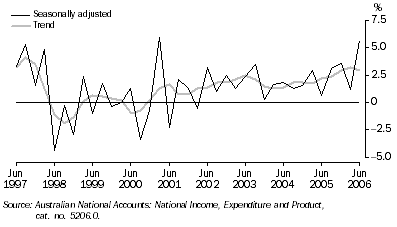
In seasonally adjusted chain volume terms, Western Australia's State Final Demand rose by 5.6% ($1,443 million) in the June quarter 2006, the highest of all states and territories - followed by the Australian Capital territory (2.6%) and Queensland (0.7%). The main driver of growth in Western Australia was Private business investment, which rose by $670 million (11.7%) during the quarter, mainly on Non-dwelling construction and Intangible fixed assets. Investment on Non-dwelling construction rose by $616 million (24.7%), as a result of new oil and gas and other infrastructure projects commencing in the state. Investment on Intangible fixed assets increased by $49 million (12.7%), as mineral and petroleum exploration activity returned to more normal levels following the impact of Tropical Cyclones Clare and Glenda on exploration in the March quarter 2006.
Solid contributions were also made to June quarter growth by the other major components of the Western Australia domestic economy, including Public investment (up $273 million or 24.2%), General government final consumption expenditure (up $207 million or 5.7%), Household final consumption expenditure (up $149 million or 1.2%) and Dwelling investment (up $80 million or 4.8%).
PRICES
Consumer Price Index
Perth's Consumer Price Index (CPI) rose by 1.8% in the June quarter 2006, the largest quarterly increase since September 2000 and higher than the national rise of 1.6%. The main contributors to Perth's CPI growth were Automotive fuel (up 11.3%), Fruit (up 39.2%) and House purchase (up 3.8%).
The increase in Perth's fuel prices reflected ongoing appreciation in world crude oil prices. Growth in fruit prices was mainly attributable to the cost of bananas almost tripling during the quarter, due to shortages created by Tropical Cyclone Larry in March 2006. However, prices also rose for citrus fruits, berries and other fruits, reflecting increased demand for banana substitutes. Escalating house prices, and shortages of skilled labour and materials in the building sector, are among the major factors driving up the cost of purchasing a house in Perth. Established house prices rose by 11.9% in Perth during the June quarter, while project home prices (newly constructed houses) increased by 3.9%.
CONSUMER PRICE INDEX (ALL GROUPS), Change from same quarter previous year
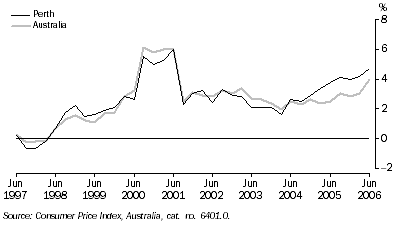
Perth's CPI increase of 4.7% through the year to June quarter 2006 was much higher than the 4.0% growth recorded nationally. The higher result for Perth was largely due to an 8.9% rise in Housing prices, more than double the 3.5% increase nationally. National CPI growth of 4.0% was a sharp rise from the 3.0% increase through the year to March quarter 2006. As a result, national CPI growth has moved to a position above the upper limit of the Reserve Bank of Australia's target range for inflation (3%).
Wage Price Index
Wages growth has increased in Western Australia over the last two quarters, with the state's Wage Price Index (total hourly rates of pay excluding bonuses) rising by 1.3% in the June quarter 2006, following increases of 0.7% in December 2005 and 0.9% in March 2006. Western Australia's growth in wages was against the national trend, which slowed from 1.0% to 0.8% in the June quarter.
WAGE PRICE INDEX, Change from same quarter previous year
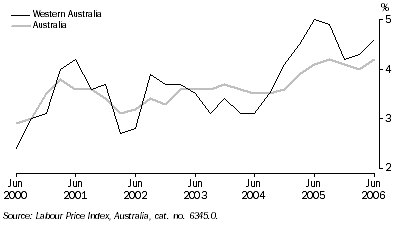
In annual terms, Western Australia's Wage Price Index rose by 4.6% through the year to June quarter 2006, up from 4.3% in the previous period. Wages growth was strong in the industries of Construction (8.9%) and Mining (7.1%), the two key sectors driving the economy. Among occupations, wages growth was high for Labourers and related workers, rising by 5.9% through the year. Growth in wages through the year in Western Australia has remained above the national average since late 2004. Australian wages grew by 4.2% in the latest period.
CONSUMPTION
Retail trade
Retail turnover in Western Australia increased by 2.9% ($159 million) in trend terms over the three months to July 2006, following a rise of equal magnitude in the previous three month period (2.9%). Growth in monthly retail turnover has decelerated in Western Australia since March 2006 from 1.1% to 0.8% in July 2006. Nationally, growth in retail turnover in the three months to July 2006 was significantly less than in Western Australia, increasing by only 1.7%, and had decelerated from a 1.9% rise in the previous period. The slowing of growth in retail turnover, both in Western Australia and nationally, coincides with a 25 basis point rise in official interest rates to 5.75% by the Reserve Bank of Australia in May 2006, which may have had some impact on consumption spending leading up to the rate rise and beyond.
MONTHLY RETAIL TURNOVER, Current prices
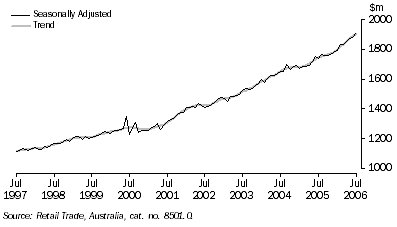
Growth in Western Australia's retail turnover was across all industry groups over the three months to July 2006, with the exception of Recreational good retailing, which decreased by $13 million or 4.4%. The largest increases were recorded in the industries of Household good retailing (up $51 million or 5.2%) and Hospitality and services retailing (up $50 million or 7.6%).
New motor vehicle sales
New motor vehicle sales (trend) in Western Australia have risen for seven consecutive months, increasing by 1.4% (130 vehicles) to 9,458 vehicles in August 2006. This was the highest level of sales since the series began in January 1994. Despite the continued growth, the rate of increase in new motor vehicle sales has decelerated over the last two months, from a peak of 1.7% (154 vehicles) in June 2006 to 1.4% in August.
NEW MOTOR VEHICLE SALES
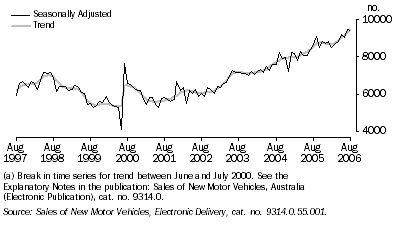
Over the three months to August 2006, sales of new motor vehicles (trend) rose by 4.8% (1,293 vehicles) in Western Australia, compared to the previous three month period. In contrast, national sales of new motor vehicles fell by 0.6% over the same period. The rise in Western Australia was mainly driven by sales of Passenger vehicles, increasing by 5.8% or 890 vehicles, although sales were also higher for Sports utility vehicles (up 4.7% or 248 vehicles) and Other vehicles (including utilities, vans, trucks and buses) (up 2.5% or 155 vehicles) over the period.
INVESTMENT AND FINANCE
Private new capital expenditure
Private new capital expenditure has increased for eight successive quarters in Western Australia, rising from $2,258 million to a record high of $4,421 million between the June quarters of 2004 and 2006 (in trend chain volume terms). Growth has been particularly strong in recent quarters, with business investment increasing by over 13% in each quarter from September 2005 to March 2006 and by 7.3% in the June quarter 2006. Growth of $299 million in the latest quarter was primarily driven by expenditure on Buildings and structures (up $240 million or 9.7%) and to a lesser extent expenditure on Equipment, plant and machinery (up $14 million or 0.9%).
With investment on Buildings and structures rising well above that of Equipment, plant and machinery, a new cycle of investment activity appears to be well underway in Western Australia. Notably, the current level of investment on Buildings and structures ($2,720 million) is more than two and half times the level it was at its peak in the previous cycle of investment a decade ago ($1,085 million in December quarter 1995).
PRIVATE NEW CAPITAL EXPENDITURE, Chain volume measures
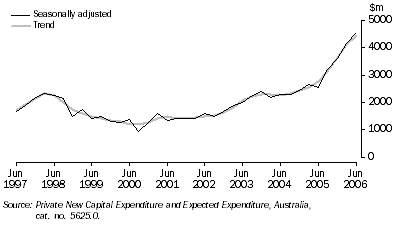
In original current price terms, business investment in Western Australia rose by $2,192 million (83.3%) through the year to June quarter 2006. This growth was mainly attributable to investment by the Mining industry, which more than doubled through the year (up $1,738 million or 113.7%) to $3,267 million. Over the same period, investment was also strong for Other selected industries, increasing by $444 million (64.0%).
Housing finance commitments
The number of dwellings financed (trend) in Western Australia has risen for 26 consecutive months, from 6,652 in May 2004 to a record level of 9,791 in July 2006. However, growth in the number of dwellings financed has decelerated over the last five months, from 232 (2.6%) in February 2006 to 79 (0.8%) in July 2006. Notably, since the rise in official interest rates by the Reserve Bank of Australia in May 2006 (up 0.25% to 5.75%), the number of dwellings financed in Western Australia has continued to decline in original terms, from a peak of 10,951 in May 2006 to 9,537 in July 2006.
HOUSING FINANCE COMMITMENTS, Number of dwellings financed
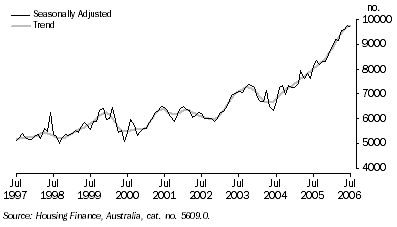
Despite the monthly decline in dwellings financed (original) since May 2006, there were still 3,762 (14.1%) more dwellings financed over the three months to July 2006, than in the previous three month period. All of this rise was attributable to dwellings financed by Non-first home buyers, increasing by 3,931 (17.6%), while dwellings financed by First home buyers decreased by 169 (3.9%). The decline in the number of First home buyers in the housing market coincides with rising interest rates, a large increase in house prices in Perth during the June quarter 2006 (11.9% for Established homes and 3.9% for Project homes) and an increase in the average home loan for First home buyers to $221,800 in July 2006, above the average home loan of $219,100 for change-over buyers.
CONSTRUCTION
Building approvals
In trend terms, there were 6,778 dwellings approved for construction in the three months to July 2006 in Western Australia, only 11 (0.2%) less than in the previous three month period. House approvals fell by 102 dwellings (1.8%), while Other dwelling approvals rose by 91 dwellings (7.8%). Monthly house approvals appear to be trending downwards in Western Australia, reaching a peak of 1,877 dwellings in February and March 2006, and since falling to 1,821 dwellings in July 2006.
NUMBER OF DWELLINGS APPROVED, Houses: Trend
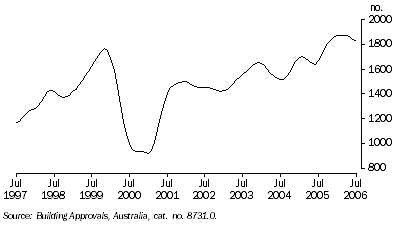
Despite the declining number of dwelling approvals, the value of buildings approved in Western Australia has risen significantly in recent months. In original terms, the value of New other residential building approvals more than doubled in the three months to July 2006, increasing by $195 million (135.7%). The value of New house approvals also rose during the period, up by $151 million or 14.1%.
TRADE
In spite of exports continuing to increase, the value of Western Australia's trade surplus fell for the first time in more than two years, decreasing by 10.2% through the year to June quarter 2006. The decline was the result of imports growth (up 65.3%) greatly exceeding exports growth (up 16.4%) over the period. The value of Western Australia's imports in the June quarter were bolstered by higher import prices and increased imports of capital goods, particularly a large floating offshore storage facility. The value of the state's exports were hampered by lower cereals, petroleum, oil seeds and fruit exports in the June quarter, while oil and gas exports continued to be adversely affected by the cyclone activity in the previous quarter.
VALUE OF WESTERN AUSTRALIA'S TRADE SURPLUS, Change from same quarter previous year
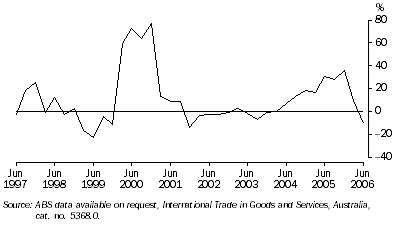
The value of Western Australia's trade surplus fell by $732 million to $6,412 million between the June quarters of 2005 and 2006. The decline was mainly the result of the state's trade balance falling with the Republic of Korea (down $683 million), Singapore (down $591 million) and Indonesia (down $404 million). There were significant gains however in the state's trade balance with the United Kingdom (up $1,221 million), Saudi Arabia (up $270 million) and China (up $239 million).
Exports
The value of Western Australia's exports rose by 16.4% ($1,812 million) to $12,848 million through the year to June quarter 2006. The major commodities contributing to the increase were Non-monetary gold (up $1,068 million or 75.1%), Iron ore and concentrates (up $287 million or 9.9%) and Nickel ores and concentrates (up $127 million or 104.9%). Exports of petroleum detracted from growth during the period, as Crude petroleum oils declined by $297 million (20.3%) and Refined petroleum oils declined by $7 million (6.8%) - the result of the prolonged impact of Tropical Cyclones Clare and Glenda on oil production.
Imports
The value of Western Australia's imports rose by 65.3% ($2,544 million) to $6,437 million through the year to June quarter 2006. Non-monetary gold (up $1,214 million or 196.4%), Ships, boats and floating structures (up $581 million or 7,071.6%) and Refined petroleum oils (up $484 million or 177.3%) were the major commodities driving growth through the year. Much of the increase in gold and petroleum imports was the result of rising prices, with Non-monetary gold prices increasing by 50.9% and Petroleum and petroleum products prices rising by 41.5% for Australian imports over the period.
MINING
Mineral and petroleum exploration expenditure
In seasonally adjusted terms, mineral exploration made a slight recovery in Western Australia, rising by $3 million (1.7%) in the June quarter 2006, to reach $147 million. This was the first increase since expenditure on mineral exploration peaked at $159 million in the March quarter 2005, five quarters ago. In original terms, the rise in mineral exploration was much more pronounced, increasing by $35 million (28.6%) in the June quarter 2006, recovering from the impact of Tropical Cyclones Clare and Glenda on exploration activity in the previous quarter (down $37 million or 23.1%). The increase in mineral exploration was mainly on Iron ore (up $16 million or 52.9%), Gold (up $10 million or 18.2%) and Base metals (up $10 million or 41.6%) during the June quarter.
MINERAL EXPLORATION EXPENDITURE, Total minerals
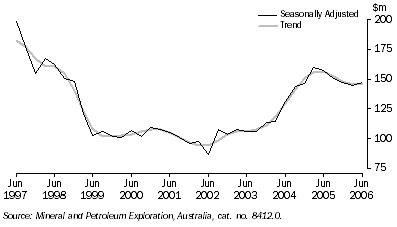
Despite the recovery in the most recent quarter, Western Australia's expenditure on mineral exploration decreased by $11 million (6.4%) through the year to June quarter 2006. The major minerals driving the decline were Nickel, cobalt (down $16 million or 39.2%) and Diamonds (down $1.3 or 34.2%), while Silver, lead, zinc partially offset the fall (up $4 million or 222.2%). Petroleum exploration expenditure in Western Australia increased solidly from a downturn in mid-2005, rising by $39 million (30.4%) through the year to June quarter 2006.
Mineral and energy production
The production of major minerals and energy in Western Australia made some recovery during the June quarter 2006, following the interruptions caused by the cyclone activity in the previous quarter. Production increased for Diamonds (up 43.7%), Iron ore (up 15.9%), Nickel (up 8.1%), Bauxite (up 6.6%), Natural gas (up 6.2%) and Gold (up 2.5%), but fell for Zinc (down 20.0%), Electricity (down 6.6%), Ilmenite (down 4.6%), Coal (down 2.6%) and Crude oil (down 2.1%). The most notable increases in Western Australia's mineral and energy production through the year to June quarter 2006 were for Zinc (up 100.0%), Coal (up 12.4%) and Bauxite (up 10.9%), while production was lower for Crude oil (down 33.9%) and Diamonds (down 20.4%).
TOURISM
Short-term arrivals on holiday
The number of overseas visitors arriving by air on holiday to Western Australia fell by 7,141 (13.9%) in the three months to June 2006, compared to the same period of 2005. The largest declines were in visitors from Singapore (down 6,367 or 39.4%), Malaysia (down 2,472 or 35.0%) and Japan (down 1,177 or 22.3%). Partially offsetting these declines were more visitors from the United Kingdom and Ireland (up 1,871 or 27.7%) and continental Europe (up 566 or 13.7%).
SHORT-TERM OVERSEAS VISITOR ARRIVALS AND RESIDENT DEPARTURES, By air on holiday: Original
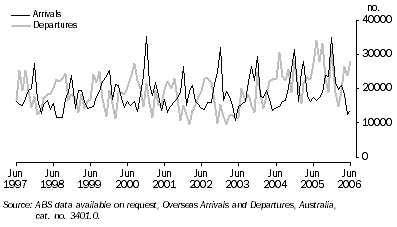
Short-term departures on holiday
The number of Western Australian residents departing overseas by air on holiday rose by 4,604 (6.3%) in the three months to June 2006, compared to the same period of 2005. The largest increases were in resident departures to Thailand (up 5,165 or 119.4%), the United Kingdom and Ireland (3,643 or 48.3%) and continental Europe (up 3,270 or 45.7%). However, there were 13,514 (53.1%) fewer Western Australian residents holidaying in Indonesia in the last three months (compared to the same period of 2005), following the Bali bombing in October 2005.
LABOUR MARKET
Job vacancies
The number of job vacancies (original) in Western Australia rose by 600 (2.9%) in the May quarter 2006, the second successive quarterly rise. The number of job vacancies now stands at 21,200 in the May quarter, 6,700 (46.1%) more than in the same period of 2005. Contributing to this rise was an increase of 6,500 (49.2%) private sector vacancies and 200 (15.0%) public sector vacancies. With job vacancies rising in Western Australia, the number of employed persons can also be expected to increase in the coming quarters.
Employment
The number of employed persons (trend) in Western Australia rose by 6,600 (0.6%) in the three months to August 2006, following growth of 6,800 persons (0.6%) in the previous three month period. The entire increase over the last three months was driven by full-time employment, up by 10,700 persons (1.4%), while part-time employment fell during the period. Growth in full-time employment was driven by both males (up 6,100 persons or 1.2%) and females (up 4,600 persons or 1.9%). There were 1,074,000 persons employed in the state's labour force as at August 2006, with 767,700 (71.5%) of them employed full-time.
EMPLOYED PERSONS, Total
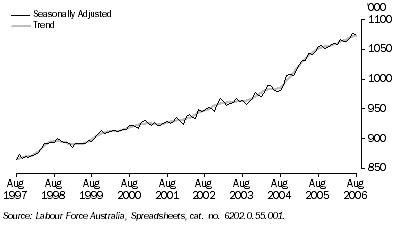
The main industries contributing to employment growth (original) in Western Australia through the year to August 2006 were Property and business services (up 13,000 persons or 10.9%), Manufacturing (up 11,800 persons or 13.3%) and Wholesale trade (up 8,000 persons or 20.2%). Partially offsetting these increases were declines in Agriculture, forestry and fishing (down 13,900 persons or 24.6%) and Retail trade (down 8,700 persons or 5.6%). The major occupation contributing to state employment growth over the period was Tradespersons and related workers, up by 11,500 persons (7.8%), while Managers and administrators recorded the largest decline in employment, falling by 16,200 persons (17.3%).
Unemployment
The number of unemployed persons (trend) in Western Australia fell by 3,500 (8.7%) in the three months to August 2006, following a decline of 4,800 persons (10.7%) in the previous three month period. The continued decline in unemployed persons in the state's labour force has seen the unemployment rate drop from 3.6% in May 2006 to a record low of 3.3% in August 2006 - well below the national rate of unemployment of 4.8% in August.
UNEMPLOYMENT RATE
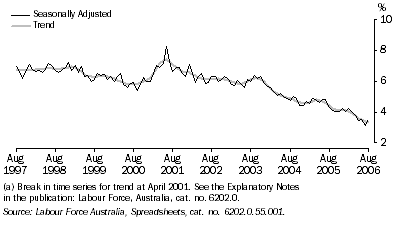
Participation
Western Australia's labour force participation rate remained steady at 67.6% in each month between May and August 2006.
SOCIAL TRENDS - EDUCATION, TRAINING AND WORK
Students
In 2005, there were 338,300 full-time students attending primary and secondary schools in Western Australia, an increase of less than 1% from the 336,100 in 2004. The proportion of full-time students in the state's government schools fell from 73.9% to 67.6% between 1995 and 2005, reflecting the national trend of increased participation in private schools. The rate of decline has been more rapid in Western Australia than for Australia, bringing the proportion of the state's students in government schools closer to the national average in 2005 (67.1%).
FULL-TIME STUDENTS, Percentage enrolled in government schools
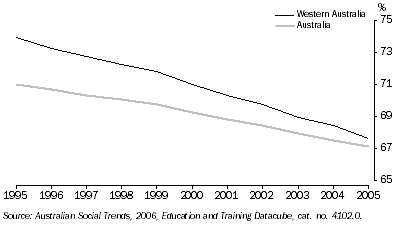
Education participation
In 2005, 69.7% of 15-19 year olds in Western Australia were participating in formal education, this was below the national average of 76.0%. While higher than the rate ten years ago (64.9%), education participation for 15-19 year olds in Western Australia has generally decreased since 2000 when the rate was 75.5%. The strong labour market in Western Australia may, in part, be contributing to lower education participation rates for this age group. Between 2001 and 2005, the labour force participation rate for persons aged 15-19 years in Western Australia increased from 63.1% to 65.7% and the unemployment rate decreased from 5.6% to 4.4%.
EDUCATION PARTICIPATION, Persons aged 20 to 24 years
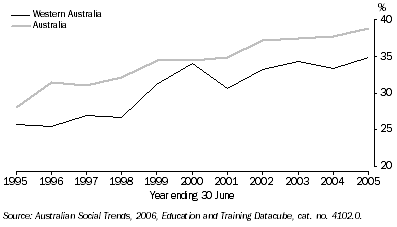
Growing emphasis on the need for higher educational qualifications and skills has contributed to a marked increase in the educational participation of Western Australians aged 20-24 years over the past decade. In 1995, 25.7% of this age group were participating in education, but by 2005 this proportion had increased to 34.8%. Nationally, the education participation rate for this age group increased from 28.0% to 38.9% over the same period.
Labour market outcomes
Educational attainment and labour market outcomes are closely associated with qualified people less likely to be unemployed. In 2005, the unemployment rate of people with a non-school educational qualification in Western Australia (2.8%) was significantly lower than that of persons without qualifications (6.8%). For those with a Bachelor degree or higher qualification, the unemployment rate in 2005 was 2.2%, a 1.2 percentage point decline from the previous year.
 Print Page
Print Page
 Print All
Print All